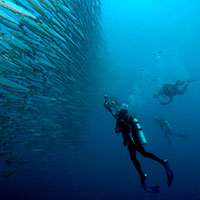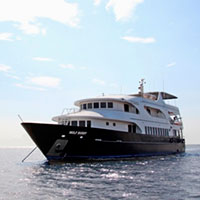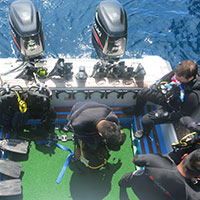Our dive shop is located on Academy Bay on Santa Cruz island in the heart of the Galapagos. From here, we can visit all of the best dive sites in the Galapagos! Whether you’re a certified diver looking for daily dive trips or you’re ready to learn and get PADI certified, we can accommodate all levels of divers from all around the world. Diving in the Galapagos is worthy of your bucket list, so let’s go diving!
(Ready to book a dive? Browse our Galapagos Islands Diving Tours)
We offer several options for you to enjoy the Galapagos dive trip of a lifetime:

Daily Dive Tours
See more by taking one or more of our daily dive tours.

Dive Packages
See the amazing life of Galapagos below and above the water.

Liveaboards
Go there in comfort and style on 1 of 5 different liveaboards.

PADI Dive Courses
Learn to dive, expand your experience or help others
Diving tours in the Galapagos are often a once-in-a-lifetime opportunity. This diverse, extraordinary archipelago offers a stunning variety of wildlife alongside typically very good dive conditions. From good visibility to comfortable temperatures, you might be in the middle of the Pacific Ocean, but you’ll be overjoyed with the scuba diving in the Galapagos!
To help you plan your dive trip, we want to offer all the information you might need. Of course, you can always feel free to get in touch. with any questions at all. We also offer Galapagos Islands tour packages. and Galapagos land tours. for you to enjoy during your visit. While we’re here for the exceptional diving, there is so much to explore above the surface, too!
The best time to dive in the Galápagos islands is any month of the year! We can see the marine life here all year round, you just need to decide how warm you like your water.
The Galapagos Islands diving season can be split in two: wet and dry. Choosing when to dive really depends on what wildlife you want to see.
The warm season is from December to May due to the Panama current in the north picking up strength, with water temperatures around 22C – 27C. The visibility is, on average, a bit better because the Humboldt Current slacks off and there is not so much nutrient in the water. The days are hot and humid with clear blue skies.
During February – April, we definitely recommend a hotel with AC as average temperatures are 30 – 35C day and night with humidity around 80% – 85%.
January to March usually bring heavy rains, but it’s normally only early morning or overnight, which makes the days very humid.
These months will give you a slightly higher possibility to see larger schools of hammerhead sharks, White tipped reef sharks, and many marine turtles and schools of rays.
The clouds start to appear in June and it gets steadily cooler through July – November with average temperatures being 18 – 24C. The Humboldt Current becomes stronger and brings colder water and welcome nutrients for the marine and bird life, giving an average water temperature of 18 – 20C, but we do get some days at 16C, so if you feel the cold bring your layers and your hoods! Dry suits are definitely the envy of divers using rental wetsuits during these days. Always check your Galapagos water temperature before diving!
These months are the “high season” for the liveaboards as the nutrient rich waters attract the giant Whale Sharks to the waters around Wolf and Darwin islands. Though the water is cold, the marine life is still abundant around the central islands also, with Mola Mola sightings increasing around Gordon Rocks.
If you plan to do any walking on the island during this time, bring a lightweight rain jacket or poncho, as the misty rains “garua” are very frequent, especially in the highlands where the tortoises live.
A word of warning: The sea breezes in the Galápagos Islands create a wonderful climate, but don’t be fooled by the overcast skies.
In Ecuador, you will pay painfully for deciding you don’t need your sunscreen, as we are very close to the sun! Follow this advice: Always wear sun protection, including a hat to protect your upper head and face, as well as sunglasses and light, loose clothing.
Use waterproof sunscreens with an SPF factor of at least 15; if you easily burn, go for the SPF 50, take a full bottle, and remember to apply it everywhere (including in less obvious places, such as the top of your feet and ears).
Many a day has come to an end with bright red bodies after snorkel trips or, the most notorious of all… a trip to Tortuga Bay! We also suggest bringing a bottle of high-quality aloe vera gel and a lycra rash vest. These recommendations apply to the Ecuadorian mainland also. Being at altitude can contribute to terrible sunburn, so bring plenty of sunscreen.
Our boat is a 12-meter custom-built dive speed boat with twin 250hp engines. It took its maiden voyage in May 2017, making it the fastest and most modern dive boat in the Galapagos area. The boat has a private pump toilet as well as comfortable cushioned seats and plenty of room to relax in the sun between dives.
Everyone knows diving has the potential to become a dangerous pastime, but if you follow the rules and stay within your limits we believe diving is the best sport out there!
Academy Bay Diving and its crew put your safety as our utmost concern, even higher than catching that glimpse of the Hammerhead sharks, which is why our company has a ZERO dive accident record.
In the unlikely and unfortunate event of a dive accident or passenger emergency, all of our crew members, Instructors, Dive masters, sailors, and Captain have received dive first aid training & emergency oxygen administration training.
We also have the added benefit of having a qualified Emergency Nurse with Hyperbaric medicine training on staff.

Flying after diving is a question we get asked at least once every day. The recommendations from DAN (Divers Alert Network), is to wait a minimum of 18 hours after doing a 2-tank dive session before flying. See their recommendations on their website
Therefore, diving the day before you leave Galapagos with Academy Bay Diving is definitely possible as we leave early in the morning and finish our dives normally by 11:30 at the latest.
The flights that leave the Galapagos start at 10am, giving you at least 23 hours’ rest time.
There are 2 Hyperbaric Chambers on the island of Santa Cruz for scuba divers in the Galapagos. One is a private chamber that can be used by anyone with or without dive insurance (at a cost of course), and the other is a DAN-run chamber that treats only dive injuries of those divers with DAN insurance (can be purchased over the internet before treatment in some cases).

Daily Dive Tours
See more by taking one or more of our daily dive tours.

Dive Packages
See the amazing life of Galapagos below and above the water.

Liveaboards
Go there in comfort and style on 1 of 5 different liveaboards.

PADI Dive Courses
Learn to dive, expand your experience or help others